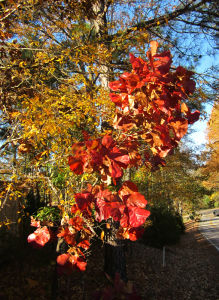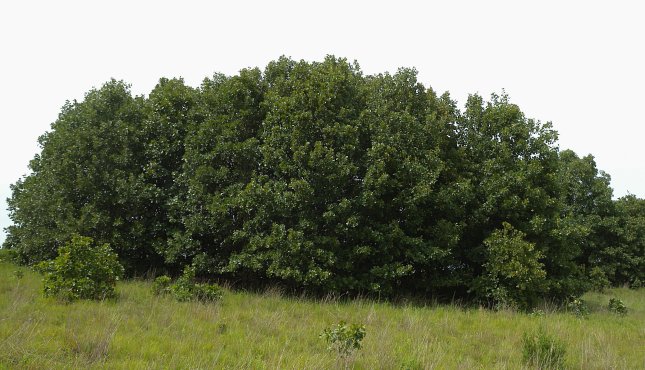Blackjack Tree Leaves
Knowing how to identify tree leaves can help to know which trees are growing in woodlands, forests, or parks. It is possible to identify leaves by their shape, edging, size and patterns. Some deciduous trees have tree leaves that are heart, ovoid, rounded, lanceolate, and triangular shapes. Evergreen coniferous trees have leaves that look like needles or clusters of scales.
Blackjack leaves are very high in fibre, which among many other things help with the management of diabetes, maintaining a healthy heart (avoiding cardiovascular diseases) and maintaining a healthy digestive system. So go on right ahead and try this recipe out. The two leaves in the bottom row resemble the two types of leaves I find attributed to the blackjack oak in my reference books. The leaf on the left looks like the blackjack oak leaf in my Audubon field guide. The leaf on the right is similar to the blackjack oak leaf in Trees and Shrubs of Kentucky. Thus, the tree from which the bottom two. The best and most characteristic leaves of any tree come from mature individuals, as you might expect. Also, blackjack leaves are typically much larger, and with a good bit of reddish hairs on.
Eastern redbud is a small deciduous tree. Trees typically grow 20 feet in height with a similar spread and have gracefully ascending branches and a rounded shape. Eastern redbud leaves are alternate, simple, broadly heart-shaped and 3 to 5 inches high and wide. Leaves emerge reddish, turning green as they expand. Blackjack cannot be stored for more than one day. The leaves can be stored in a fridge or consumed after harvest. Leaves may also be parboiled and then dried in the sun for later use. Marketing Fresh tender leaves, shoots and young plants are collected for household consumption and sometimes sold at local markets. PRODUCTION SCHEDULE.
In this article, you will learn about leaf identification and how to recognize the different parts and structures of tree leaves. The leaf shapes mentioned in this identification guide also apply to other plants such as flowers, shrubs, and bushes.
Tree Leaf Identification
There is much more to identifying tree leaves than just by their shape. Ovate-shaped tree leaves can be rounded, elongated, or taper to a point. Also, the margins of these leaves can be smooth, serrated, notched, or lobed. When trying to identify a tree by its leaves, you can also notice the venation patterns on the leaf as well as its color and size.
Another clue as to the tree species is by looking at how the leaves are arranged on the stem. You may notice in some pictures of leaves and stems that some leaves grow opposite each other and some are arranged in an alternate pattern. These are all different ways to identify tree species by their leaves.
Knowing the terms of how leaves are identified (called leaf morphology) is a great way to learn how to identify many trees and plants.
Types of Tree Leaves with Pictures for Easy Identification
Before looking at how to tell apart species of trees by the shape of their leaves, let’s look at how leaves grow on stems.

The way that leaves grow on stems is called phyllotaxis in botanical terms.
Opposite Leaves
Opposite Leaves grow in pairs on either side of the stem
As the name suggests, opposite leaves that grow on stems grow directly opposite each other. Looking at pictures of opposite leaves, you will see that the leaves are in pairs on either side of the stem.
Opposite leaves grow on the same plant node – this is the point on the stem where the stems, buds, or leaves grow from. Many types of trees have stems with opposite leaves and the leaf shape depends on the species of tree. Leaves that grow opposite each other can be simple leaves or compound leaves.
Trees with examples of opposite leaves include maples, ash trees, elders, olive trees, and eucalyptus.
Alternate Leaves
Alternate leaves on stems grow in a staggered pattern and they look like each leaf grows in between the leaves on the opposite side. This means that each plant node only has one leaf growing from it.
Examples of trees with alternate leaves include oak trees, sycamore, mulberry, birch, hickory, and willow.
Whorled Leaves
Whorled leaves radiate from a single point and surround the stem
The third type of leaf arrangement that is found on some trees is whorled leaves. Whorled leaves grow in a similar way to opposite leaves. However, instead of having just 2 leaves in an opposite arrangement, there are 3 or more leaves growing from each node on stems with whorled leaves.
There are not many trees or shrubs which have whorled leaves.
Simple Leaves
Simple leaves have single leaf blade. In the photo: maple leaf
Another way to identify types of trees by leave is if they have simple leaves or compound leaves. These terms refer to the number of leaves that grow on the petiole. The petiole is the small thin stalk that is attached to the stem and the leaf blade (lamina).

Foliage on trees and plants that is made up of simple leaves only have a single blade growing on the stalk. So, a simple leaf just has one blade on each petiole. Simple leaves can grow in alternate arrangements or opposite arrangements on the stem.
Examples of deciduous trees with simple leaves include maple trees, sycamore trees, elm trees, and oak trees.
Compound Leaves
Compound leaf consists of several leaflets joined to a single stem
Compound leaves are when there are a number of leaflets growing on one leaf stalk (petiole). You can think of this as a number of small leaves that grow together to form a complete leaf.
It can be tricky to know if the leaf you have in your hand is a simple leaf or compound leaf. One way to tell them apart is to see if there is a node where the leaf/leaflet joins the stem. If there is a node, then you have a simple leaf, whereas a lack of node indicates it is a compound leaf.
Examples of trees with compound leaves include ash trees, walnut trees, hickory trees, and horse chestnut trees.
There are a number of types of compound leaves, and knowing about them can help make tree identification easier.
Types of compound leaves. From left to right: pinnate leaves, palmate leaves and double pinnate leaves
Pinnate leaves (compound)
Trees that have pinnate leaves mean that the leaflets on the compound leaf grow in each side along the length of the petiole like a feather arrangement. Sometimes these types of leaves called pinnately compound leaves.
Examples of pinnate leaves are found on trees such as walnut, ash, pecan, and hickory trees.
Palmate leaves (compound leaves)
Palmate leaves have a number of leaflets growing at the end of the leaf stalk. These compound leaves usually look like the shape of a hand with a palm and fingers. That is why they are called palmate leaves.
Trees that grow palmate leaves include horse chestnut and buckeye trees.
Double pinnate (bipinnate) leaves
Trees with bipinnate leaves have leaves that resemble fern leaves. You will notice in pictures of double pinnate leaves that the compound leaves are made up of a number of secondary stems that have leaflets growing in an opposite arrangement.
Some examples of trees with bipinnate leaves are honey locust trees, the Texas redbud, and Kentucky Coffee trees.
Lobed, Toothed, or Entire Leaves

You can identify a tree by its leaf shape. From left to right: unlobed leaf, lobed leaf and toothed leaf
One very important way to identify types of tree leaves is by the overall shape of the leaf around its edges. The edges of leaves create patterns that are often unique to the species of tree and help with identification.
Entire leaves (unlobed)

Most oval or round-shaped leaves are called ‘entire leaves.’ This means that the leaf edge is smooth and round without having any special features. Later in the article, you will learn more about the specific shapes of entire leaves. These types of leaves can also be called unlobed leaves.

Lobed leaves
Lobed leaves can have rounded tips like the white oak leaf (left) or pointed tips like maple leaf (right)
The most easily identifiable type of tree leaf is the lobed variety. These leaf blades are made up of earlobe-like shapes, but they form a single leaf. The clefts or indentations between the lobes can be deep or shallow depending on the type of tree. The space or indentation between two lobes is called sinus.
Some examples of trees with lobed leaves include oak trees and maple trees. You will see in pictures the differences between the types of lobes these leaves have. Maple trees have pointed lobes, whereas white oak tree leaves have a rounded lobe shape.
Blackjack Oak Tree Leaves
Toothed leaves
Leaves with a serrated edge or with tooth-like shapes around the margins are called toothed leaves. Depending on the species of tree, the toothed edges can be so fine that you have to look close to notice them. Other types of toothed leaves can look like a steak knife. Some types of toothed leaves have a softer edge with rounded ‘teeth.’
Examples of trees that grow toothed leave are chestnuts, elms, hazel trees, rowan, and ash trees.
Evergreen Coniferous Tree Leaves
Although they may not look like leaves, coniferous evergreen trees such as pine, spruce, cedars, and fir trees have leaves. Evergreen coniferous trees leaves are generally made up of needle-like leaves that can be soft or hard.
Let’s look in more detail at the different types of coniferous leaves.
Single Needles
Many trees in the conifer class Pinopsida have aromatic leaves that are classed as ‘single needles.’ This is where the rows of needles are attached directly to the twig. The types of conifers with single needles are fir trees, spruces, and cypress trees.
Cluster and Bundle Needles
Pine trees have cluster needles
The other type of evergreen conifer leaf can be described as cluster or bundle needles. These grow like clumps of evergreen needles along the twigs of the tree. You can use the type of needle leaves to tell pines apart from fir trees because pines have cluster needles.
Leaf Shape, Margin, and Venation
We have looked at ways of identifying leaves by looking at the way they are arranged on the stem and their overall shape. Tree leaves come in all sorts and sizes, and knowing the shape of particular leaves can help to quickly identify the tree species.
Tree leaf shapes
Tree leaf chart: Leaf shape and arrangement. Image by Wikimedia Commons
Looking at the shape of the leaf is usually the first way people try to identify the species of tree. Usually, the leaf shape and its margins can help to tell a lot about the kind of tree it came from.
Some of the most common shapes of leaves include the following:
- Ovate leaves are egg-shaped with the widest point being nearer the stalk
- Obovate describes a tear-shaped leaf where the tapered end is at the stalk
- Lanceolate is a leaf shape that looks like the tip of a lance
- Acute leaf shapes are elongated and slightly oval and have a pointed tip
- Rhomboid leaves are triangular-shaped leaves that may or may not have tooth edgings
- Spatulate leaves are, as their name suggests, in the shape of a spatula
In addition to the mentioned leaf shapes, it is good to remember that the shape of the leaf doesn’t determine the leaf arrangement. For example, ovate and lanceolate leaves grow on stems as compound leaves or alternate leaves.
Tree leaf margins or edges
Tree leaf chart Leaf margins have many types of edging. Image by Wikimedia Commons
For many types of leaves, their overall shape and pattern are greatly defined by their margins. This is especially true when it comes to identifying trees such as oak and maple trees that have lobed leaves.
Leaf margins are classified by the type of edging that may be lobed, smooth, or toothed. Some of the other terms used to define leaf margins include:
- Crenate leaves have rounded teeth around the edges
- Dentate leaves also have teeth-like shaping around the edges, but they look sharp, not round
- Serrated leaves look like the teeth on a circular saw
- Undulate leaves have a wavy pattern around their edges
Another factor that affects the overall shape of the leaf is the depth of the spaces between the lobes. Some leaves with deep lobes may look almost like pinnate leaves. However, lobed leaves with very shallow lobes have a more undulated look.
Tree leaf venation
Tree leaf chart: Vein structure in leaves. Image by Wikimedia Commons
Blackjack Tree Leaves
Knowing the structure of the veins in tree leaves is another important fact in identifying the type of leaf. Leaf veins are important to transport nutrients to all parts of the leaf. The veins in each leaf also play an important role in photosynthesis.
All types of leaves have a central vein called the midvein or midrib. Small veins or capillaries branch out from the midvein to form intricate patterns in the leaf structure. Some patterns in tree leaf venation include the following:
Blackjack Oak Tree Leaves Pictures
- Pinnate veins branch out in opposite directions from the central vein that runs the length of the leaf
- Palmate capillaries branch out from the midvein to form the shape of a leafless tress
- Rotate veins look as if they branch out in all directions from a central point and look like spokes on a wheel
- Dichotomous veins branch out in pairs to the edge of the leaf
Blackjack Tree Leaves Pictures
Related articles: